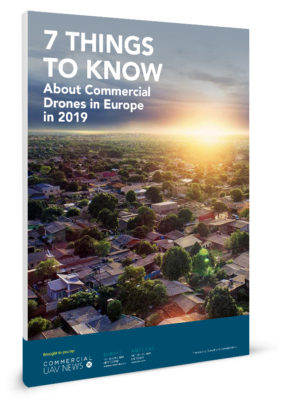There is a concerted effort by the 32 state members of the European Aviation Safety Agency (EASA) to integrate UAVs into the continental airspace. At the same time, regulators from individual countries and drone manufacturers are working together to make sure the industry benefits from the unified legislation in terms of innovation, leadership and of course, sales.
Drones in Europe are a rapidly developing sector. It is expected that within 20 years the European drone sector will directly employ more than 100,000 people and have an economic impact exceeding €10 billion per year, mainly in services. All of the efforts to advance common rules and regulations will help ensure these jobs are both created and maintained.At Amsterdam Drone Week last November, EASA held their High Level Conference on Drones. In two days of invitation-only sessions, top aviation and industry stakeholders discussed the future of drone regulations and the drone industry in Europe. During a plenary session on the New European Regulatory Framework, representatives from industry and regulatory agencies discussed the appropriate framework for drone regulations: performance-based, collaborative, and global.
Download the free "7 Thing to Know About Commercial Drones in Europe in 2019" report
Three Categories
The proposed EASA regulation for drones across Europe creates three categories: open, specific and certified. Implementing regulation currently only relates to the open and specific categories.The open categories are in principle low-risk drones. They do not require prior authorization by the competent authorities, nor a declaration by the drone operator before the operation takes place. But if the weight more than 250 grams, they will need to be registered.The requirements refers to line of sight operations, maximum platform weight of 25 kg, maximum altitude 120 m a.g.l. (except where flying over a fixed obstacle over 70 m), limited flight over uninvolved people and complying with certain criteria. A remote pilot must have the ability to take control, so autonomous operations are excluded.The specific category means a category of drone operations that considering the risk involved require an authorization by the competent authority before the operation takes place, except for standard scenarios for which a declaration by the drone operator is sufficient or when the operator holds a light drone operator certificate with privileges.A certified category means a category of drone operation which requires the certification of the drone and its operator as well as licensing of the flight crew.
Koen De Vos from the European Commission will showcase a European Roadmap for the Safe Integration of Drones at Commercial UAV Expo Europe. Click here to see the full conference program.
A Pan-European Endeavor
Critically, EASA’s effort involves stakeholders from every member country.“We’ve been learning by doing,” says Pekka Henttu, a representative from TRAFI, Finland’s Transport Safety Agency. “My expectation and hope is that we’ll have harmonized regulation – which will bring Europe to the top of the industry,”“For the first time in history, aviation becomes a truly commercial product,” says Daniel Wiegand, the CEO of Lilium, a heavy lift electronic vertical takeoff and landing (eVTOL) aircraft, commenting that performance-based regulation is the best stepping stone towards a regulatory framework.Steve Nordlund of Boeing agreed with Wiegand. “Aviation is being used in ways – and in industries – that it’s never been used before,” he says. “Complementary regulatory activity around the world is incredibly important. Maintaining the level of safety – or even improving the level of safety – is the commitment that we need to have…. a tight collaboration between industry and regulators globally is incredibly important.”Christoph Raab, CEO of Drone Alliance Europe, emphasized that cooperation between countries is crucial. “Our approach is a harmonized approach. We need one set of regulations across Europe,” he says, commenting that small businesses especially need the leverage of a larger market. “It’s about creating wealth, and jobs, and business. The more we have globally interoperable rules, the more benefit we will have,” says Raab. “It’s important that international regulators are aware of this.”Raab also sees the importance of talking to communities about the benefits of drones. “We should not speak about acceptance, but explain the social value… that should be on the forefront on our minds.”Asked if we’ve made appropriate progress in the industry towards regulation, Nordlund says the enormous growth of the industry so far indicates progress. He emphasized again that collaborative activities between industry and regulators are critical to growth – in activities he described as “test and learn,” focused on solving problems with this new form of aviation. “We’re just starting,” he says.While acknowledging that all stakeholders may not agree on the EASA Basic Regulation effort, “We’ve opened the door,” says Henttu. “…We’ve started the conversation.”The conversation among aviation regulators is similar around the world – issues of safety, privacy, cybersecurity, public acceptance, and industry adoption are all complex and difficult topics. But in Europe, those issues are being addressed with a view towards global cooperation and the growth of the drone market. This effort is not only good for European drone companies, and good for Europe as a whole.At the same time, the European Commission (EC) has promised to help European drone makers. At an EC meeting earlier in the year in Brussels, discussions of transport regulation centered around issues of competition. Transport Commissioner Violeta Bulc argued that consolidated, European-wide regulations would allow European countries to manage airspace less expensively and to become world leaders in the aviation industry, particularly for the newly developing drone market.Ms. Bulc said that anticipated drone regulations will create “a European-based regulatory framework” which will “create the conditions” for European drone manufacturers to become world leaders. The Transport Commissioner promised that proposed laws will “strike a balance between safety, security, legal certainty, privacy and data protection requirements.”“It will really enable the drone industry in Europe to take off,” she said.The above mentioned first package of drone regulations, which are part of a larger “aviation package” designed to create common regulations throughout the aviation industry, will help cut the costs of airspace management. This approach underscores EASA's intention that will allow individual member states to draft their own rules on where and when drones can fly, but that the European Commission will create common standards on design, production, and certification of drones.Commercial Drone Opportunities in Europe
While the US and Israel currently dominate the world markets for military drones, European commercial firms are growing, and lawmakers hope that a consistent regulatory framework will encourage development. The 2014 TNI report “Eurodrones” concluded that the European Commission should shift focus from military drones to expanding the commercial market, recommending “a policy designed by the drone industry, for the drone industry.”The daily Brexit debates continue, but Members of the European Parliament have backed a revision of aviation safety rules to ensure that the future use of drones is safe for everyone across Europe. Throughout the European Union, manufacturers and operators have existed under different sets of rules and regulations. With this EASA initiative, all of that is set to change. A common set of principles for drone use and operation will make sure that everyone adheres to consistent rules – meaning greater safety for the public.The proposed measures cover all aspects of the industry. Drones will have to be designed to ensure that the public’s safety is not put at risk. This will mean that the weight of unmanned aircraft will be important, and where drones can fly (at what height and distance) will also be thoroughly monitored. Drones also will require new features that have been discussed and tested but not widely rolled out. This includes automated landing systems and emergency parachute deployments to manage situations where an operator loses control or contact with a drone in flight. It will also see collision avoidance systems becoming integral to drone operations.Coverdrone’s FlySafe App already offers operators a quick way of planning flights and flying their drones safely. FlySafe is linked to Altitude Angel’s GuardianUTM platform and supports commercial UAV pilots. However, onus will be on drone operators to be fully aware of all the rules that apply to them. Anyone who flies a UAV must be able to operate the aircraft safely, without putting members of the public or other airspace users at risk.Although most commercial operators undergo full and thorough flight training, the new rules will mean that more drone operators could be required to complete training ahead of being able to operate a drone. The rapid evolution of the UAV industry has meant that rules and regulations must change. The numbers of small unmanned aircraft being flown by commercial operators and hobbyists have increased beyond all expectations in recent years.There have been near-misses, but the changes go much further than simply trying to avoid physical crashes. EASA now seeks to create a safe, transparent and well-governed drone industry. Many drones (depending on size and weight) will need to be properly recorded on national registers. The provisional recommendations were approved by a large majority (558 votes to 71), but the new rules will need to be approved by the EU ministers.Summary Of New Proposed EU Drone Rules:
- New drone rules agreed to ensure common levels of safety across EU countries
- Operators of drones of 250g or more are to be registered
- Drones must not be operated at a height of more than 400ft above the surface
- Drones restricted to flying within 1km of protected aerodromes
- Drone designs must ensure they can be operated without putting people at risk
- Drone operators must be aware of all the rules that apply to them















Comments